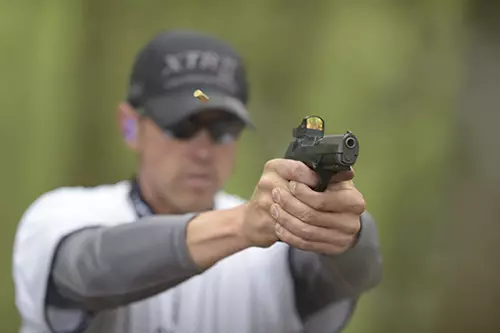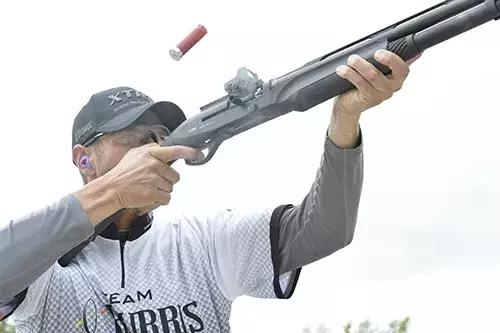How a Red Dot Sight Works

What is a Red Dot Optic?
A red dot sight is an optic designed to be used at close to moderate ranges. It is a very simple optic that uses a simple reticle to do a simple job. If you can’t tell by the name, these optics use a red dot as the reticle.
Well sometimes the dot can be green, but those are still known as red dots just for simplicity’s sake. Because of how simple and straightforward a red dot is, it’s one of the best tools for training new shooters.
Red dot optics are 1x optics and do not feature a built-in magnification. This is why we don’t call them scopes, but red dots, or optics, or red dot optics.
Invented in the mid-70s red dots have come a long way in the past 40+ years and have especially seen major advancements in battery life, clarity, and quality in the past 10 years.
Like all technology, they’ve shrunk in size and gotten to the point where they range from full-sized rifle optics to optics small enough for duty handguns.
How Do They Work?
A simple optic should work simply, right? Well, there is a little technological magic to it. Red dots uses the same principle as an old magician’s trick known as Pepper’s Ghost. The idea is simple you utilize plates of glass and a light.
A red dot has a spherical mirror that reflects the light emitted from an LED of its axis focus. That spherical reflector has a special coating that only reflects red light. This prevents other light from disrupting your reticle.
To break it down simply an LED shines a beam of light onto a specially coated, slightly angled piece of glass. That glass reflects the light from an LED onto it, creating your reticle.

This allows you to see your reticle and see through your optic, but someone on the other side of the optic cannot see your reticle.
The size of a red dot is measure in MOA, and that size is controlled by an aperture hole in front of the led.
Typically bigger dots are quicker to see and get on target, smaller dots are better for shooting at moderate distances. At longer ranges, the dot covers less of the target and makes seeing and hitting your target significantly easier.

Different Types of Red Dots
There are several different kinds of red dot optics out there that all fill different roles or perform slightly differently.
Standard Rifle Optics
The vast majority of your red dots are tube based designs made for full sized firearms. These optics often feature a 2 to 3 MOA red dot, a 25mm or more objective lens, and are designed for close to moderate range shooting.
Standard rifle optics can often be mixed with a magnifier or night vision optic to increase the range and versatility of the platform.
Miniature Red Dots
Miniature red dots are the smallest of the small. These tiny red dot optics are designed and fitted as both pistol sights and backup sights for standard rifle optics. Miniature red dots are getting smaller and smaller every year and becoming a real option for CCW.
The FastFire 3 is one such red dot. After reviewing it in our Best Pistol Red Dots article - we at PewPewTactical named it our Editor’s Choice for Most Affordable.
Why Do You Want One?
The first reason you want a red dot sight is for simplicity’s sake. Everything about them is simple, and that’s the key to their success. Red dot optics are insanely easy to use and very easy to get and stay on target with.
I love red dots for training new shooters. I make sure it’s zeroed, hand it to a new shooter and tell them to put the red dot wherever they want to hit. Their simplicity makes them easier to use than irons and keeps new shooters feeling good about hitting the target.
The next reason is speed. I’ve never measured how fast I am with irons versus red dots, but I know the difference is significant. From a low ready position, I can be putting accurate rounds on target in less than a second with a red dot. With irons, I have to make sure they are aligned correctly which takes time.
A red dot sight also allows you to look through the optic at less than perfect angles. If you are shooting in a rush, you may not get perfect alignment, or be right behind the red dot, but if you can see the dot, you can hit your target.
Red dots can also easily be switched from weapon to weapon. A full-size red dot is at home on an AR just as much as it's at home on a shotgun. This level of versatility is only found in the red dot optic realm.
A red dot on a handgun is also a game changer. Red dots have gotten to the point where they are small enough for duty and even concealed carry, These are a significant game changer to the handgun world.
They offer a massive amount of benefits to the handgun platform, including longer range, a more precise aiming system, and faster first shot advantage.
Red dot optics continue to be a game changer when it comes to modern tactical applications, as well as sport shooting, home defense, and competition use.
The Future is Red
Red dots are amazing little optics and these days we are seeing hundreds of them on the market. Like always some names will rise above the rest. Red dot sights aren’t going anywhere anytime soon.
Their adoption by military and police forces around the world have guaranteed they are going to be around for a long, long time. They will continue to grow and evolve, and the future of red dots is going to be bright.

FastFire 3
The Burris FastFire 3 is one of our most versatile products. It is popular for use on sidearms, as a co-witness sight on tactical weapons, on short range rifles, on shotguns, and even on the Burris Spotting scope.